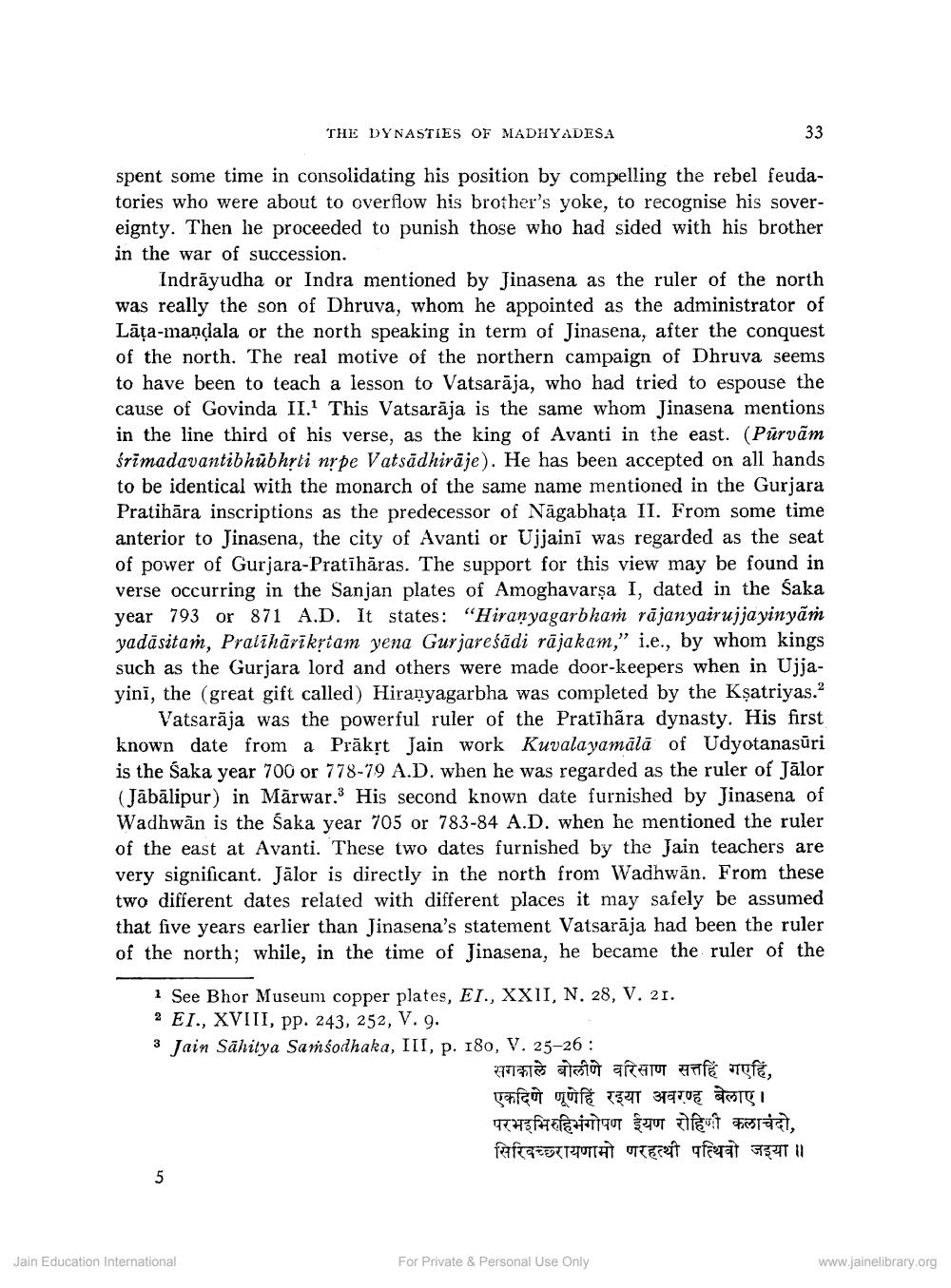________________
THE DYNASTIES OF MADHYADESA
33
spent some time in consolidating his position by compelling the rebel feudatories who were about to overflow his brother's yoke, to recognise his sovereignty. Then he proceeded to punish those who had sided with his brother in the war of succession.
Indrāyudha or Indra mentioned by Jinasena as the ruler of the north was really the son of Dhruva, whom he appointed as the administrator of Lāța-mandala or the north speaking in term of Jinasena, after the conquest of the north. The real motive of the northern campaign of Dhruva seems to have been to teach a lesson to Vatsarāja, who had tried to espouse the cause of Govinda II.' This Vatsarāja is the same whom Jinasena mentions in the line third of his verse, as the king of Avanti in the east. (Purvām śrimadavantibhübhrti nr pe Vatsādhirāje). He has been accepted on all hands to be identical with the monarch of the same name mentioned in the Gurjara Pratihāra inscriptions as the predecessor of Nāgabhața II. From some time anterior to Jinasena, the city of Avanti or Ujjainī was regarded as the seat of power of Gurjara-Pratīhāras. The support for this view may be found in verse occurring in the Sanjan plates of Amoghavarsa I, dated in the Saka year 793 or 871 A.D. It states: "Hiranyagarbham rājanyairujjayinyām yadāsitam, Pratīhārī krtam yena Gurjareśādi rājakam," i.e., by whom kings such as the Gurjara lord and others were made door-keepers when in Ujjayinī, the (great gift called) Hiranyagarbha was completed by the Ksatriyas.?
Vatsarāja was the powerful ruler of the Pratīhāra dynasty. His first known date from a Prākịt Jain work Kuvalayamālā of Udyotanasūri is the Saka year 700 or 778-79 A.D. when he was regarded as the ruler of Jālor (Jābālipur) in Mārwar. His second known date furnished by Jinasena of Wadhwan is the Saka year 705 or 783-84 A.D. when he mentioned the ruler of the east at Avanti. These two dates furnished by the Jain teachers are very significant. Jālor is directly in the north from Wadhwān. From these two different dates related with different places it may safely be assumed that five years earlier than Jinasena's statement Vatsarāja had been the ruler of the north; while, in the time of Jinasena, he became the ruler of the
1 See Bhor Museum copper plates, EI., XXII, N. 28, V. 21. 2 EI., XVIII, pp. 243, 252, V. 9. 3 Jain Sahitya Samsodhaka, III, p. 180, V. 25-26 :
सगकाले बोलीणे बरिसाण सत्तहिं गएहिं, एकदिणे णूणेहिं रइया अवरण्ह बेलाए। परभइभिरहिभंगोपण ईयण रोहिणी कलाचंदो, सिरिवच्छरायणामो णरहत्थी पत्थिवो जइया ।।
Jain Education International
For Private & Personal Use Only
www.jainelibrary.org




